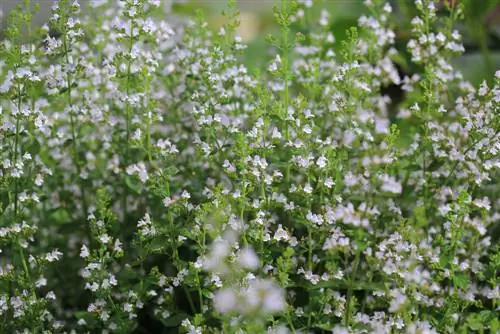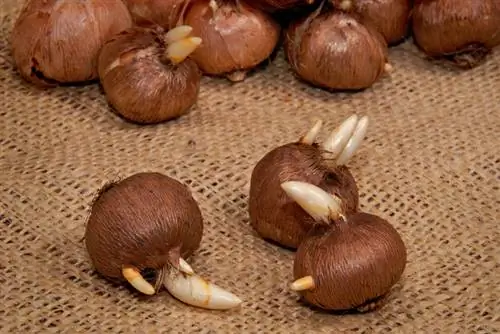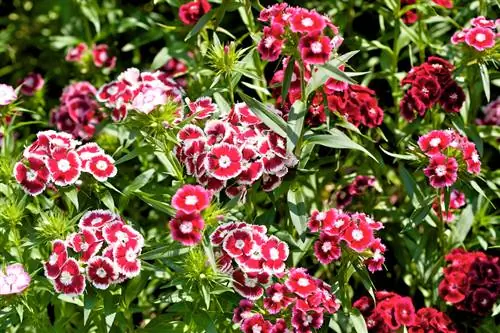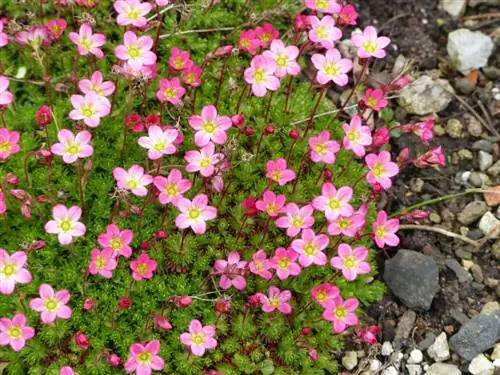- Author admin [email protected].
- Public 2023-12-16 16:46.
- Last modified 2025-06-01 06:02.
Read the commented mountain mint profile here for compact information about growth, flowers, uses and five beautiful Calamintha species. Lots of tips about sowing, planting and caring for stone thyme.

What is mountain mint and what is it used for?
Calamint (Calamintha) is an easy-care, hardy perennial that grows 20-60 cm high and produces fragrant flowers in colors such as white, bluish, purple or pink. It thrives best in sunny, dry locations and is suitable for garden beds, rock gardens, containers and as a bee pasture. Important species in Europe are C. nepeta, C. menthifolia, C. grandiflora and C. alpinum.
Profile
- Scientific name: Calamintha (formerly Clinopodium)
- Genus: Mountain mints with about 17 species
- Synonym: stone mercury
- Family: Mint family (Lamiaceae)
- Occurrence: Europe, Asia, America
- Growth type: Perennial
- Growth: upright, bushy
- Growth height: 20 cm to 60 cm
- Leaf: oval, serrated
- Flower: Lip Blossom
- Winter hardiness: hardy
- Use: bed, pot, bee pasture
Growth
The mountain mint is the hobby gardener's ace in the hole for a summer flower fairytale for the benefit of people and insects. The natural beauty can be seen from a distance with a delicate mint scent and the loud buzzing and humming of busy bees. The following overview attempts to summarize the picturesque composition of flower magic, splendor of colors and scent experience in factual key growth data:
- Growth type: perennial herbaceous plant with hairy leaves and numerous labiate flowers along the stems.
- Growth habit: depending on the species, loosely bushy-upright and clump-forming or prostrate and cushion-forming.
- Stem: square
- Growth height: 20 cm to 60 cm, during the flowering period up to 80 cm.
- Roots: flat, creeping rhizomes.
In 2009, the classification of the mountain mint genus was reorganized with 17 recognized Calamintha species. The former genus Clinopodium contained up to 200 species, which are now found in their own genera and subfamilies within the mint family.
Bloom
The fragrant flower clouds of a mountain mint consist of crowds of delicate individual flowers that gather to form dense inflorescences. Under ideal conditions, a lush sea of flowers unfolds that covers all the leaves. A Calamintha flower can be recognized by these characteristics:
- Inflorescences: short-stemmed, cluster-like with 5 to 20 individual flowers and lanceolate bracts.
- Single flower: tubular to bell-shaped 2-5 cm long labiate, 5 petals, 2 to 5 stamens.
- Flower color: depending on the species, white, bluish to pastel purple, pink to reddish, violet shades.
- Flower ecology: hermaphrodite, rich in nectar (insect value 4)
- Flowering period: depending on the species from May to August or June/July to September/October
The high-quality insect value and the long flowering period make mountain mints important traditional plants. Especially in the period when there are few flowers from late summer to late autumn, stone thyme plants offer wild bees, honey bees, bumblebees and butterflies a rich nectar buffet.
Video: Stone thyme and other bee magnets in the late summer garden
Leaf
The simple appearance of mountain mint leaves makes up for it with an aromatic mint scent. A stone mercury leaf can be clearly recognized by these features:
- Leaf shape: stalked, ovate to oblong-oval, pointed, toothed leaf margin, 2 cm to 8 cm long.
- Special features: woolly hairy, the mint scent intensifies when rubbed, edible.
- Leaf color: gray-green to blue-green, some species with a silvery shimmer.
- Arrangement: opposite
Species
In Germany, Austria and Switzerland, the mountain mint genus is represented by these five garden-friendly species:
| Camerin species | Small-flowered mountain mint | Large-flowered mountain mint | Forest mountain mint | Alpine stone quendel | Red mountain mint |
|---|---|---|---|---|---|
| Botanical name | Calamintha nepeta | Calamintha grandiflora | Calamintha menthifolia | Calamintha alpinum | Calamintha sylvatica |
| Growth height | 30-40 cm | 20-40 cm | 30-60 cm | 15-20 cm | 40-50 cm |
| Flower color | whitish-light blue | purple pink | white-light purple | red-violet | violetpink |
| Flowering time | July to October | May to August | June to October | June to September | July to September |
| Speciality | for stony, barren soil | 3-4 cm large bell flowers | Tolerates partial shade | cushion-forming, lying down | Pioneer Plant |
Usage
Chill mints green stony, barren areas with natural charm. In addition to their valued function as decorative pioneer plants, Calamintha species are recommended for a variety of uses. Let these ideas inspire you to creatively integrate stone thyme into the design of your bed and balcony:
- In the natural garden and perennial bed: scented plant, backdrop plant, border, bee pasture.
- In the country house and farm garden: bed borders, ground cover, fence greening.
- In the rose garden: decorative accompanying perennials, picturesque underplanting of rose stems.
- In the rock garden: flower-rich planting in gravel beds, perfectly combined with sedges, chickweed or red fescue.
- In the orchard: between or under fruit trees and berry bushes as a tempting pollinator plant.
On the balcony and terrace, stone thyme is useful as a nature-loving potted plant, underplanting privacy bushes or as a fragrant pot beauty on the herb step. Small, cushion-forming species adorn the flower box as decorative hanging plants.
Excursus
American mountain mint - mock mountain mint with guard measure
The American mountain mint (Pycnanthemum pilosum) fulfills the desire for a stately perennial for the rock garden. Because the natural beauty from across the Atlantic does not belong to the mountain mint genus, it is also called hairy mountain mint. With a height of 120 centimeters, the mint plant is twice as tall as the real mountain mint. Its white bell-shaped flowers are swarmed by bees, bumblebees and butterflies. The white-purple-speckled leaves, which have an aromatic scent of peppermint and are also easy to process, set the scene decoratively.
Planting mountain mint
You can buy mountain mint ready to plant at the tree nursery or perennial nursery. Ambitious hobby gardeners opt for uncomplicated sowing. Read the best planting tips for stone thyme in the bed and on the balcony here.
Sowing
The germinating Calamintha seeds are suitable for growing on the windowsill. From the end of February, scatter the tender seeds on lean, permeable coconut soil. Do not cover the light germinators. Light pressing is enough for a good connection to the ground. Keep mountain mint seeds constantly moist in a bright location at 20° Celsius without waterlogging. The germination time is one to two weeks. After germination, place the seed container cooler at 16° to 18° Celsius. Seedlings with several leaves, separate into 9 cm pots with low-nutrient potting soil.
Location
Mountain mint is a model of frugality. The undemanding nature is reflected in these location conditions:
- Full sun, warm and dry location.
- In nutrient-poor, stony-sandy to loamy-gravelly, permeable soil.
Thanks to their good-natured adaptability, Calamintha species also tolerate a partially shaded, fresh location in normal garden soil, as long as the perennials do not have to deal with waterlogging.
Planting Tips
The time window for planting mountain mint in the bed is open from mid-May to mid-October. Stone thyme has limited hardiness in pots and is best planted in spring. Simple steps when planting set the stage for an exuberant blossom festival. It's worth taking a look at these planting tips:
- Enrich normal garden soil with sand, fine-grained grit or lava granules for optimal permeability.
- Unpot the mountain mint and plant it just as deep as before in the nursery pot or purchase container.
- Plant spacing in the bed: 35 cm or 7 to 10 plants per m²
- Planting distance in the pot and flower box: 20 cm to 25 cm.
- Use a mix of peat-free balcony plant soil (€6.00 on Amazon), coconut fiber, sand and expanded clay as the potting substrate.
- To prevent waterlogging, create a drainage system on the bottom of the pot made of broken clay, expanded clay or chippings.
Calamints look best in tuffs with three to five plants.
Care for mountain mint
The mountain mint is very easy to care for. Pruning at the right time will encourage the beautiful flowers to bloom again in autumn. Light winter protection should only be noted for potted plants and after autumn planting. It's so easy to care for stone thyme in the bed and on the balcony:
- Watering: water regularly after planting, later in prolonged drought.
- Fertilizing: Do not fertilize mountain mint.
- Pruning: Prune by half to two thirds after the first flower bloom, pruning close to the ground in late winter.
- Propagation: Division of the root ball in spring, cuttings in early summer, sowing in spring or autumn.
- Overwintering: Place the pot on wood and cover it with fleece, cover the perennial planted in autumn with leaves.
You will rarely have to complain about diseases and pests with mountain mint. Snails avoid the fragrant perennial. Aphids are also apparently deterred by the essential oils that produce the mint scent. In warm, humid weather, mildew can occur, which can be recognized by the white coating. Cut off affected plant parts and dispose of the clippings in household waste.
Popular varieties
The wild Calamintha origin species served as the floral starting point for these beautiful varieties:
- Calamintha nepeta 'Triumphator': Premium variety for beds and pots, white to pastel purple flower spikes, 35 cm small.
- Small-flowered mountain mint 'White Cloud': Calamintha nepeta with bright white flowers until autumn, 20-40 cm tall.
- Small-flowered mountain mint 'Blue Cloud': enchants with violet-blue flower clouds from July to October, 50-60 cm tall.
- Rising mountain mint 'Gottfried Kühn': particularly stable variety with purple-pink flowers, 30-50 cm high.
- Large-flowered mountain mint 'Variegata': boasts up to 4 cm large, violet-pink flowers and white-green leaves, 40 cm high.
FAQ
Are mountain mint leaves edible?
Yes, the leaves of mountain mint are edible. Essential oils give the foliage a delicious peppermint flavor. You can safely use the leaves and flowers as a culinary herb or make a refreshing tea from them.
How to propagate mountain mint?
The mountain mint is not only particularly easy to care for, but also very easy to propagate. The following methods are available: sowing, division and cuttings. Dividing has the advantage that you can rejuvenate the perennial at the same time and give new impetus to its flowering.
When and how does mountain mint get pruned?
Basically, you don't need to prune a mountain mint at all. Of course, pruning twice a year is beneficial for vitality and willingness to flower. After the first flower blooms, cut the perennial back by two thirds. With a little luck, a pretty rebloom will appear in autumn. Cut off the drawn-in plant parts at ground level in late winter, which clears the way for fresh shoots.
Can I plant early mountain mint in the bed at the beginning of May?
If you plant early mountain mint at the beginning of May, you should cover the tender plants with a fleece until mid-May. It is better if the young plants complete a hardening phase on the partially shaded balcony in front of the protective house wall until the Ice Saints arrive.
Should you plant a mountain mint with a root barrier?
The mountain mint grows to form clumps. Over the years, the perennial grows in breadth without becoming unpopular with invasive spread. In contrast to real peppermint (Mentha piperita), planting with a root barrier is not necessary.






